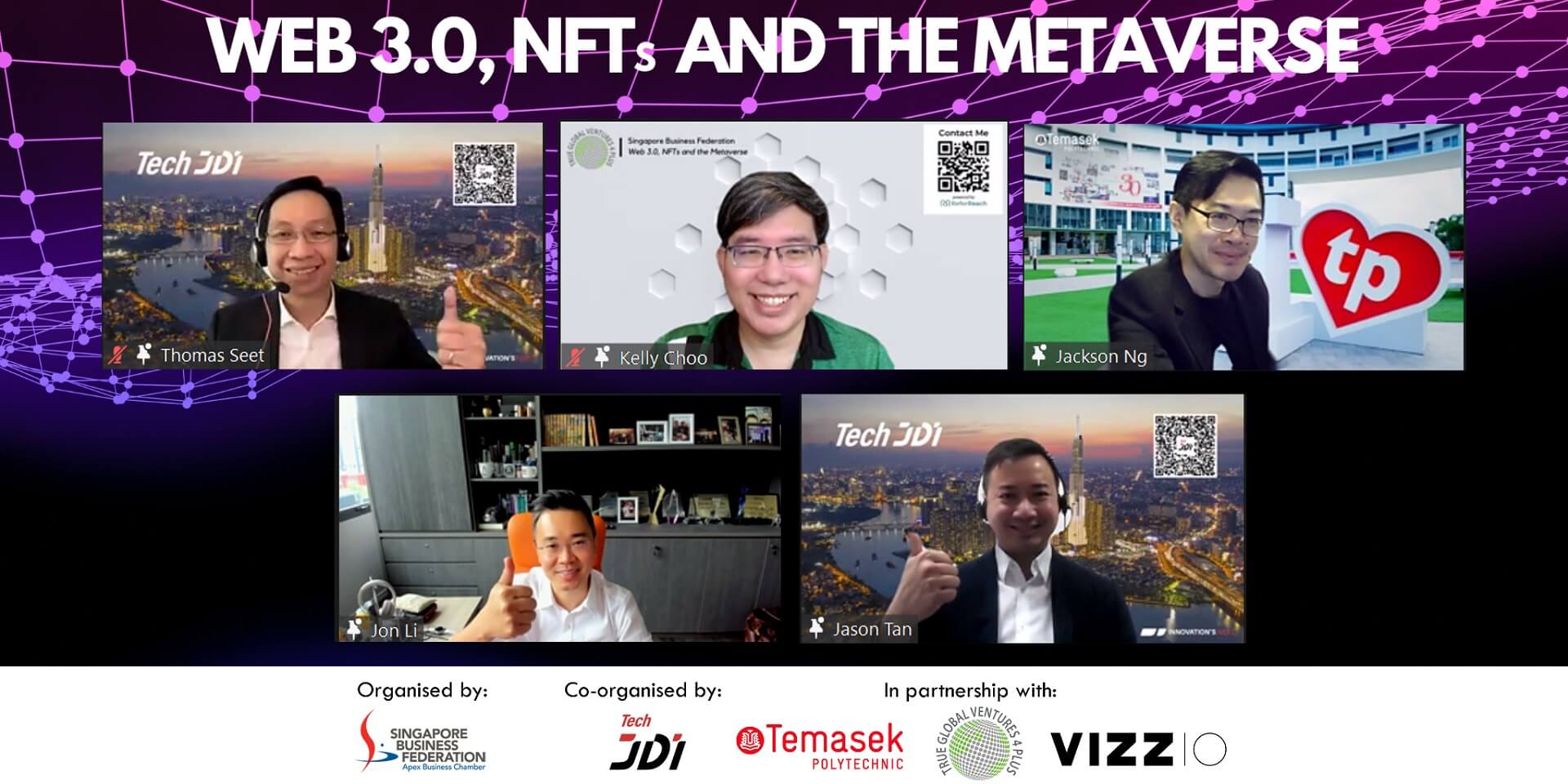We organized a webinar in collaboration with the Singapore Business Federation (SBF) to provide insights on Web 3.0, NFTs, and the Metaverse. The sharing included updates on recent market activities, as well as discussions on how organizations can seize new opportunities created during this time of massive change.
During the webinar, Thomas Seet, JDI’s Head of Corporate Venture, moderated questions from the audience about Web 3.0, NFTs, and the Metaverse in collaboration with our speakers. The list below has been compiled based on frequently asked questions.
Q.1 | Is It Necessary For Businesses To Adopt Web 3.0 Now?
Web 3.0 core tenets of a ‘decentralized’, ‘permissionless’ and ‘trustless’ internet will result in a technology industry less dominated by large tech companies that have in the past aggregated large moats of monetizable user data, thus collecting large tolls for access to their platforms and associated data.
With Web 3.0, users will have full ownership of their data and the monetization associated with it, and a ‘trustless’ internet will further help to create efficiencies in the value chain, thus unlocking value and lowering the cost of doing business.
Early adopters in this area can look forward to being at the forefront of this innovation in order to bring new business models to life and to stay competitive with leaders in their industry.
Q.2 | How Can Blockchain Technology Help To Protect Personal Or Business Information?

Blockchain technology is a form of open cryptography that leverages public and private keys to secure information alongside a publicly available registry that is managed in an automated and decentralized manner.
Once encrypted, you need both the passcode and the private key to unlock the information, making it possible for all the encrypted data to be taken and still be utterly useless to a thief.
Q.3 | When Does It Make Sense For IOT To Integrate With Blockchain?
Many businesses in Singapore have already started integrating IOT and Blockchain due to benefits that firms can reap such as creating full life-cycle visibility, tamper-resistant records of shared transactions and making user experiences more convenient and secure.
For instance, in Supply Chain Management, IoT integrated with Blockchain enables the capturing of end-to-end data related to perishable goods from producer to retailer, especially relating to locational, temperature, and other critical parameters.
In Cyber security, IoT solutions store biometric logins on the blockchain, securing and decentralizing important information required, including unique facial, eye, voice, and fingerprint details.
Q.4 | Is Crypto Laundering A Big Concern?

Money launderers seem to use fiat (like the US dollar) more than crypto, by at least 800 times more. Anything from $800 billion to $2 trillion is being laundered on a yearly basis. However, this is not the case for cryptocurrencies, as only a small fraction is being used for this purpose.
Hence, crypto laundering is not as big of a concern as compared to fiat. In addition, since all crypto transaction records are captured on the blockchain, laundering activities tend to be easier to track and trace.
Q.5 | What Are Some Possible Setbacks When It Comes To Adopting Blockchain?
When it comes to adopting Blockchain, companies may face several challenges such as complex setup, slow transaction speeds, and high energy consumption.
However, since the blockchain technology Bitcoin protocol was launched, there has been a lot of development going on over the years. Ethereum has been the alternative protocol by improving the system design to reduce the complexity of setup, lowering the cost, and increasing the efficiency of the Blockchain.
Since then, adoption has skyrocketed, and it recently launched Eth 2.0 to meet the challenges of slow transaction speeds and high energy consumption. In addition, there have been other alternative developments on alternative L1 and L2 protocols that are able to more effectively deal with the scale.
For instance, the Polygon protocol uses a “proof of stake” mechanism that draws significantly less energy than L1 protocols (like Bitcoin and Eth 1.0) that rely on “proof of work”. Aside from that, this mechanism brings other significant advantages such as higher efficiency, throughput, and faster transaction processing speed.
Q.6 | Is NFT A Hype, A Bubble or A Real Market Opportunity?

Some say NFT is a hype while others say it is a bubble. As this technology is still in its infancy, it makes it exciting and hence the hype around its potential.
Looking at the current NFT market volume trends, the rate of growth has been steady, indicating that NFTs are slowly becoming more popular and are likely here to stay. However, due to its volatile and speculative nature, there are differing views on whether the current values of NTFs are inflated or may be under-valued.
Q.7 | What Are The Requirements For Kicking Off A Metaverse Project?
As new metaverse applications are still nascent, it is important to realize that metaverse deployments may differ from more traditional digital transformation projects.
Determining your goals and objectives are critical to the success of your metaverse applications as there may be dependencies around network infrastructure, latency, availability, privacy and content management for your use cases.
If in doubt, work with the right partners who can help you find the right innovative use cases and connect with leaders in this sector who can work with you to maximize your return on investment.
Q.8 | How Can The Metaverse Be Applied In Terms Of Education, Training And Development?

When it comes to education, the Metaverse could provide better learning experiences for students where lessons can be fun and educational at the same time.
For example, lectures could be conducted similarly to an online quest, which motivates students to concentrate on learning. When it comes to testing and developing new theories, Metaverse has the capability of allowing people to apply these theories in an emulation of real-life situations.
3D interactive and virtual worlds are particularly useful when applied to training applications where technicians, engineers, and surgeons require assisted guidance for tasks that require a high level of technical specificity.
Q.9 | How Are Blockchain And Metaverse Relevant To Traditional Industries Such As Manufacturing?
Blockchain and Metaverse could be greatly beneficial to traditional industries such as manufacturing. For Metaverse, technology such as virtual reality, augmented reality, and brain-computer interfaces, which are extended reality, would be able to identify unsafe workplace conditions in advance which would help significantly reduce the number of incidents in the industry.
As for Blockchain, it can increase transparency throughout the entire supply chain by ensuring product tracking is possible for the whole process from start to end. The technology ensures the item’s credibility, detects counterfeits, speeds up production and more.
Conclusion – A New Wave Of Changes
With the world embracing digitalization, today’s businesses have learned to stay at the forefront of innovations. For companies across the globe, the next challenge is how they can adapt to Web 3.0, NFTs and the Metaverse.
If you missed our webinar — or would like to relive it — check out the recordings here. Discover how organizations are navigating the path towards new frontiers with Web 3.0, NFTs and the Metaverse and learn about the latest best practices to stay ahead of the game!
Looking to jumpstart your journey into Web 3.0, NFTs or the Metaverse? Get in touch with us!


